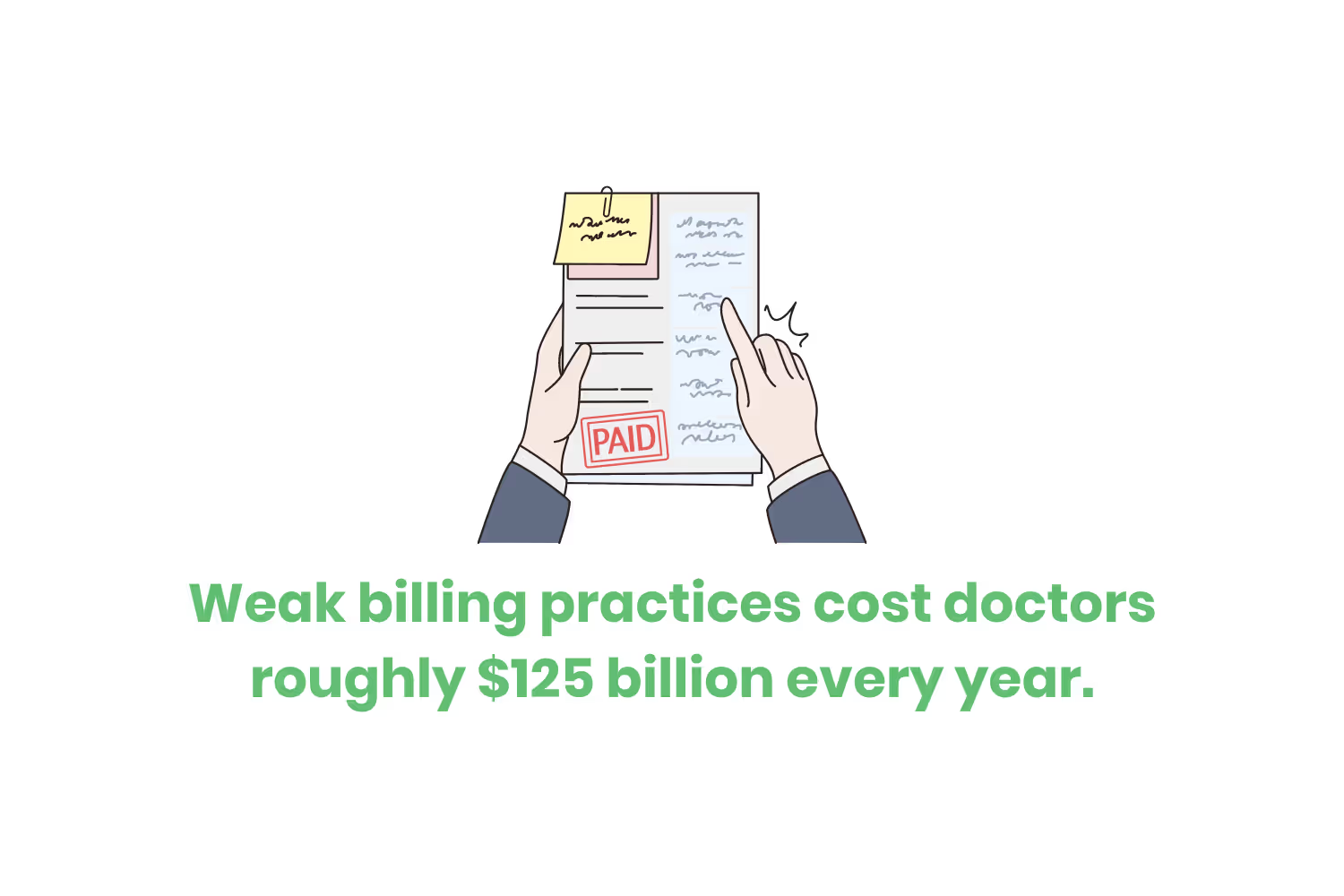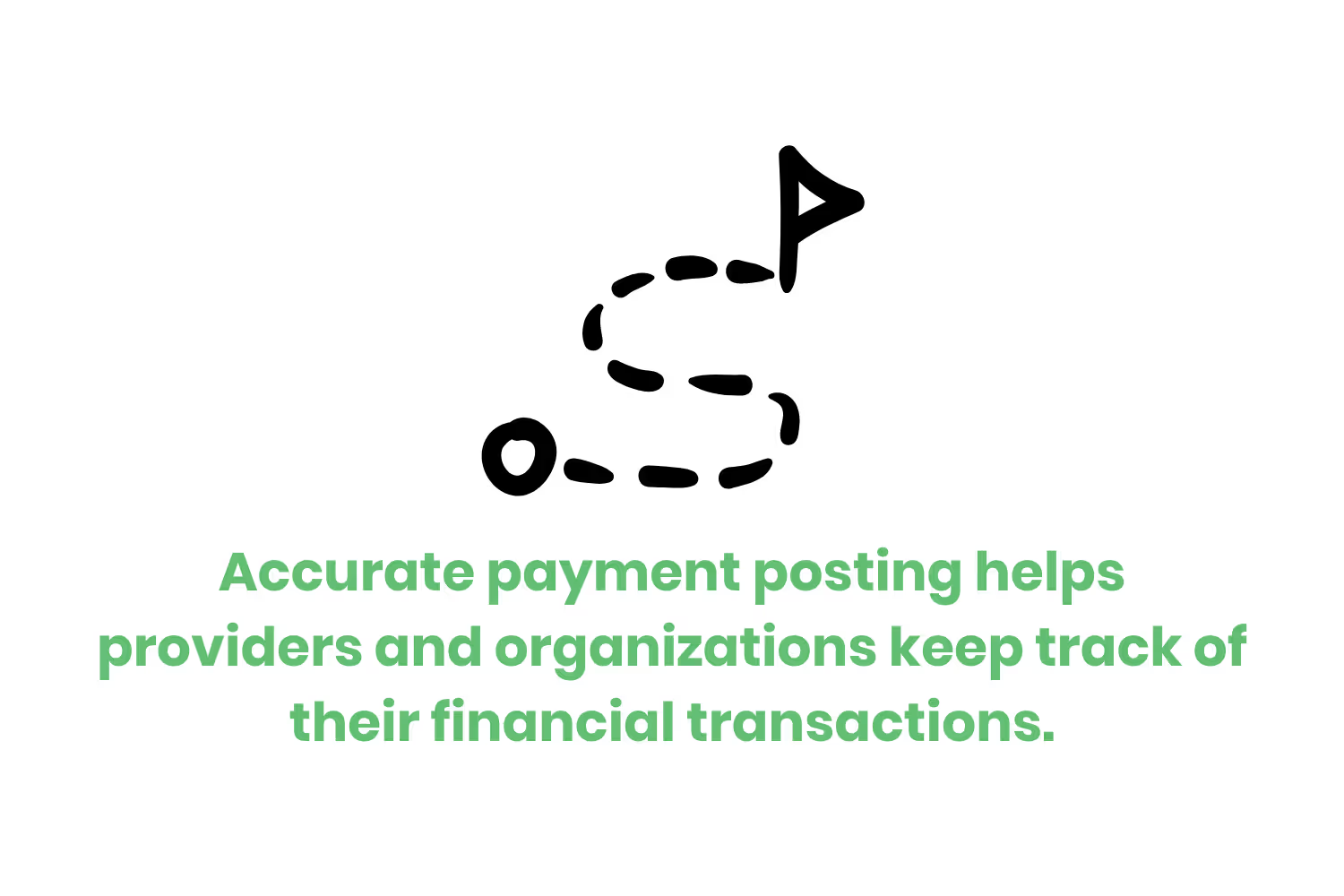Payment Posting in Medical Billing: Everything You Need to Know
In this blog, we go over the process involved in payment posting. As well as the benefits, common challenges, and more.
.avif)
According to Equifax, weak billing practices cost doctors roughly $125 billion every year. So what does it mean to have strong billing practices? Having a fortified revenue cycle management system! We’ve gone into detail about the inner mechanisms of the revenue cycle before. But what about the importance of accurate payment posting?
Ensuring a strong cash flow and seamless revenue cycle experience relies on efficient payment posting. It is one of the pillars of your revenue cycle management system that you cannot afford to overlook.

Strict attention to detail in this component of the cycle assures that practices account for all services provided. Such services include:
- Submitting claims to insurance companies.
- Reviewing information from payers. This information often regards claims.
- Coordinate claim payment posting. As well as reconciliation with patient payments. Both happen on a timely basis.
By focusing on a strong payment posting practice, you can ensure a stronger cash flow for your practice. This in turn helps you receive the maximum amount of reimbursement in a timely manner. Today we are going over the process involved in payment posting. As well as the benefits, common challenges, and more. Let’s get started!
What is Payment Posting
Although payment posting is a simple idea within the revenue cycle, understand that it is the first and most crucial stage. “Payment posting” is a term that describes examining payments within a medical business. As well as keeping track of its financial status. More specifically, this process records payments and deposits funds. This posting occurs after a medical billing procedure is complete.
Payment posting also alludes into the reconciliation of these numbers. This process offers insight to the following types of daily incoming payments:
- Tracking incoming patient payments. These payments may come in many different forms including cash, check, or credit cards. Payments received must reconcile with the patient’s account.
- Tracking insurance checks from Electronic Remittance Advice (ERA). This insurance payment type gets processed in batches. Companies do this by importing transactions into their practice management systems. Every batch is then subjected to review to identify any exceptions. These must then be properly addressed.
- Accessing insurance payments through Explanations of Benefits (EOBs). You can track these payments through the Electronic Health Record (EHR) system and secure FTPs.
- Denial posting. To receive accounts receivable accurately, medical businesses must post their claim denials. When insurance payers send back a denied claim, medical billers must record each denial in the practice management system. From there, the necessary actions that businesses may take include:
- Re-billing to secondary insurance.
- Transferring balances to patients.
- Writing off amounts.
- Resubmitting claims for processing.
Understanding the basic steps of this process is crucial for any healthcare provider. Especially when trying to optimize their revenue cycle.

Methods of Payment Posting
There are two methods of payment posting: manual and auto posting. Manual posting gets filled out by administrative staff. This method typically takes longer. So payment posting can face delays due to various problems. Such problems may include things such as typos. These specific errors are more likely to occur using this method.
Auto payment posting, on the other hand, accelerates the medical billing process. This software driven strategy offers more reliability when it comes to collecting revenue. Using this method allows larger organizations to garner better control over them. Especially in their day-to-day business aspects.
Benefits of Accurate Payment Posting
Whether you handle your bills internally, or through a third-party billing service, I think I’ve made one thing pretty clear... make sure your payment posting process is air-tight! There are so many benefits that come with a strategic payment posting procedure.
Remember that posting payments can significantly affect other aspects of your business. Two great examples include patient care and financing. Let’s talk about how payment posting helps with managing cash flow. And not only that but spotting problems and implementing modifications as well.
Comprehensive Financial Tracking
Businesses of all kinds should track their finances. The healthcare industry is no different. Accurate payment posting helps providers and organizations keep track of their financial transactions. It gives understanding and insight into the overall financial health of the business.

Accurate payment posting offers practices a clear and comprehensive record of services rendered. This record helps to create a daily financial picture. Having this picture can help medical facilities locate opportunities to increase their revenue. Payment posting also helps providers collect their revenue. And do so in the most expedited manner possible.
Timely Reimbursement
I already spoke about how to collect revenue in the most expedited manner. This is again, by having a proper payment posting procedure. But what does the procedure entail that allows for this quick financial turnaround? Prompt claim processing and reimbursement can trigger a steady and streamlined flow of funds. This is of course by minimizing delays. Some services through payment posting include posting and recognizing claim denials. Services can also help uncover procedures that need prior authorizations. By having your payment posting process address claim denials, you can rest assured your revenue will soon follow.
Electronic health record software helps to accurately update a patient’s account. This gives medical billers insight into covered services, payments received, and more. By practicing strong payment posting procedures, financial records are more likely to be accurate. This alone reduces the chances of running into claim denials and other billing problems.

Speaking of, catching errors before they even happen is another benefit of a proper payment posting procedure. This way, you won’t even have to address the denial in the first place. Other practices that do not spend time on this pillar of their revenue cycle process may wait days or even weeks to collect on these denied claims.
There will always be issues to handle when dealing with medical billing. When dealing with hundreds of claims and bills, it’s part of the job description. However, having a strong payment posting process can help mitigate and resolve these issues as soon as they occur. This way, your billing team won’t spend the majority of their time fixing errors, but instead focus on collecting revenue.
EOB and ERA Processing
We spoke about EOBs and ERAs earlier in this blog, but if you aren’t familiar with them let me explain further. The Explanation of Benefits (EOB) describes the claim procedure as well as any patient duties. Duties in this case include co-insurance, deductibles, and co-payments.
On the other hand, the Electronic Remittance Advice (ERA) gives the provider in the situation an explanation of the patient’s insurance process. So how does this have anything to do with payment posting you may ask?

Payment postings, when accurately processed, ensure data in both the EOB and ERA meet payment requirements. They allow for a practical and overall look into an organization's financial health status. It is crucial for your organization’s billing team to review EOBs and ERAs thoroughly. Especially before entering data into whatever billing software they work with. This way they can better understand any shifting trends that might affect denial rates.
Conclusion
Detailed payment posting services produce successful and efficient revenue flow. This aids your organization’s financial health. By avoiding incorrect posting, you can avoid potential bumps in the revenue cycle road such as:
- Claim denials.
- Incorrect patient data.
- Inaccurate financial records.
Of course, these things do happen naturally. It’s a part of being a medical billing specialist (unfortunately). However, a well-organized payment posting plan lowers the chances of continuously dealing with the same issues. Your denial rate is likely to go down as you fine-tune your revenue cycle management practices!
Challenges the healthcare industry faces at the hands of a poorly constructed posting process can vary. Another reason to keep your process in tip-top shape is to avoid any difficulties in reconciling your patient payments.
Payment posting processing improves an organization’s performance. It increases revenue, helps track transactions, addresses repeated or recurring problems early, and offers timely reimbursement. Of course, these are not the only benefits, but a few of the main ones I wanted to go over today.
To have your revenue cycle management system run smoothly means less administrative oversight. This gives your team time to focus on important matters such as patient satisfaction. By selecting a renowned payment posting service provider, you can better facilitate payment posting for insurance payment settlements.
Emphasize your product's unique features or benefits to differentiate it from competitors
In nec dictum adipiscing pharetra enim etiam scelerisque dolor purus ipsum egestas cursus vulputate arcu egestas ut eu sed mollis consectetur mattis pharetra curabitur et maecenas in mattis fames consectetur ipsum quis risus mauris aliquam ornare nisl purus at ipsum nulla accumsan consectetur vestibulum suspendisse aliquam condimentum scelerisque lacinia pellentesque vestibulum condimentum turpis ligula pharetra dictum sapien facilisis sapien at sagittis et cursus congue.
- Pharetra curabitur et maecenas in mattis fames consectetur ipsum quis risus.
- Justo urna nisi auctor consequat consectetur dolor lectus blandit.
- Eget egestas volutpat lacinia vestibulum vitae mattis hendrerit.
- Ornare elit odio tellus orci bibendum dictum id sem congue enim amet diam.
Incorporate statistics or specific numbers to highlight the effectiveness or popularity of your offering
Convallis pellentesque ullamcorper sapien sed tristique fermentum proin amet quam tincidunt feugiat vitae neque quisque odio ut pellentesque ac mauris eget lectus. Pretium arcu turpis lacus sapien sit at eu sapien duis magna nunc nibh nam non ut nibh ultrices ultrices elementum egestas enim nisl sed cursus pellentesque sit dignissim enim euismod sit et convallis sed pelis viverra quam at nisl sit pharetra enim nisl nec vestibulum posuere in volutpat sed blandit neque risus.

Use time-sensitive language to encourage immediate action, such as "Limited Time Offer
Feugiat vitae neque quisque odio ut pellentesque ac mauris eget lectus. Pretium arcu turpis lacus sapien sit at eu sapien duis magna nunc nibh nam non ut nibh ultrices ultrices elementum egestas enim nisl sed cursus pellentesque sit dignissim enim euismod sit et convallis sed pelis viverra quam at nisl sit pharetra enim nisl nec vestibulum posuere in volutpat sed blandit neque risus.
- Pharetra curabitur et maecenas in mattis fames consectetur ipsum quis risus.
- Justo urna nisi auctor consequat consectetur dolor lectus blandit.
- Eget egestas volutpat lacinia vestibulum vitae mattis hendrerit.
- Ornare elit odio tellus orci bibendum dictum id sem congue enim amet diam.
Address customer pain points directly by showing how your product solves their problems
Feugiat vitae neque quisque odio ut pellentesque ac mauris eget lectus. Pretium arcu turpis lacus sapien sit at eu sapien duis magna nunc nibh nam non ut nibh ultrices ultrices elementum egestas enim nisl sed cursus pellentesque sit dignissim enim euismod sit et convallis sed pelis viverra quam at nisl sit pharetra enim nisl nec vestibulum posuere in volutpat sed blandit neque risus.
Vel etiam vel amet aenean eget in habitasse nunc duis tellus sem turpis risus aliquam ac volutpat tellus eu faucibus ullamcorper.
Tailor titles to your ideal customer segment using phrases like "Designed for Busy Professionals
Sed pretium id nibh id sit felis vitae volutpat volutpat adipiscing at sodales neque lectus mi phasellus commodo at elit suspendisse ornare faucibus lectus purus viverra in nec aliquet commodo et sed sed nisi tempor mi pellentesque arcu viverra pretium duis enim vulputate dignissim etiam ultrices vitae neque urna proin nibh diam turpis augue lacus.



![[ANSWERED] What is a Long-Term Care (LTC) Pharmacy](https://cdn.prod.website-files.com/67e2b8210878abcba6f91ae6/68d687806a075a1cf64659b0_WhatisLongTermCarePharmacy_925.avif)
